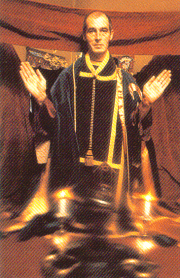
In 1953 Gardner initiated a young woman, Doreen Valiente, into the craft, and she soon went on to become the High Priestess of his Bricket Wood coven. Around the same time, Gardner invented the Book of Shadows, a workbook of rituals, although he claimed it was of ancient origins. Valiente helped Gardner rewrite the Book, cutting out what she saw as "Crowleyanity", and writing sections such as the Charge of the Goddess in poetic verse. Valiente and Gardner later fell out, however, when she got fed up with his constant attempts to gain publicity and when he tried to impose the Wiccan Laws upon the coven, something which he claimed were used by the Witch-Cult, but which Valiente believed he had simply made up. She, and several other members of the coven, left, and founded their own. However, the Bricket Wood coven continued, with members that included Jack Bracelin, Dayonis, Frederic Lamond and Lois Bourne.
Gardner also propagated his witchcraft tradition, which had begun to be referred to as "Gardnerian", outside of his Bricket Wood coven; he initiated Patricia Crowther and Monique Wilson, both of whom went on to propagate Gardnerian Witchcraft through their own covens. Various other initiates began to spread the craft around Britain, for instance Charles Clark took the religion to England's northern neighbour, Scotland.
Gardner referred to members of his craft as "the Wica", although he called the religion itself "Witchcraft", and never used the term "Wicca" in the sense as it is now known.
Meanwhile Gardner tried to get more publicity for his religion; he gave interviews to several newspapers, some of which were positive, although others turned very negative, one even declaring "Witches Devil-Worship in London!". He also published a second non-fiction book on the subject, The Meaning of Witchcraft, in 1959, as well as running the Museum of Magic and Witchcraft on the Isle of Man up until his death in 1964.


